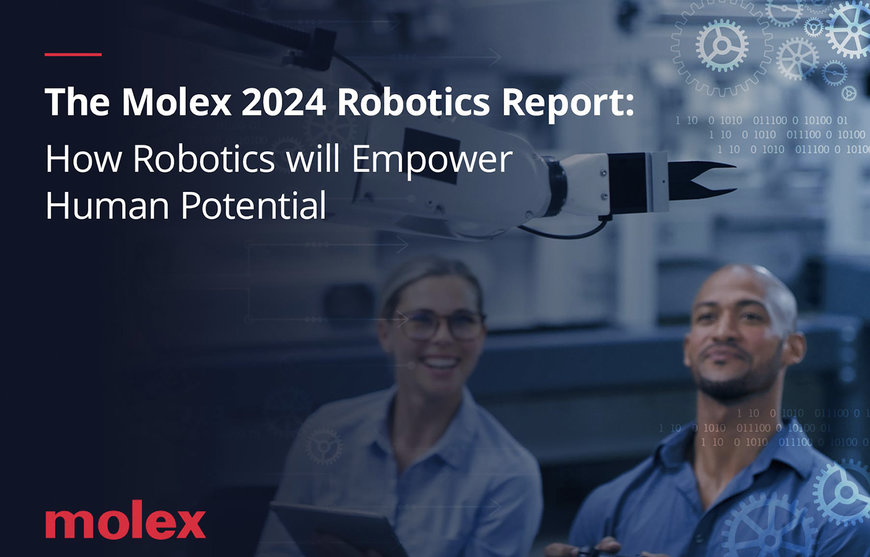Molex Unveils Robotics Report Highlighting Human-Machine Collaboration
Advances in artificial intelligence, machine learning and sensor fusion drive robotics functionality across factory, home, classroom, healthcare and military applications.
www.molex.com

Molex has issued a thought leadership report that looks at the future potential of robotics, resulting in more intuitive, intelligent and interconnected human-machine communications and collaborations. “The Molex 2024 Robotics Report: How Robotics will Empower Human Potential” contemplates a future where highly advanced robotics systems and multipurpose robots transform fundamental aspects of everyday life, from improving how factories function and students learn to making smart homes more efficient, elevating patient care and increasing support for military operations.
“As we explore the role of robotics across various industries, it is becoming increasingly apparent that the future will be shaped by the evolving relationship between humans and machines,” said Brian Hauge, SVP and president, Consumer and Commercial Solutions, Molex. “This latest industry report sheds light on a promising future of unprecedented human-machine interactions while underscoring the critical need for enabling technologies and seamless connections between robotics systems and their human counterparts to empower faster, more effective and extremely precise decision making.”
Foundational Technologies Driving Robotics Advancements
The future of robotics depends in larger part on the continued evolution of core communications and computing technologies that enable autonomous operation in dynamic environments. Topping the list is high-speed connectivity, as robotics systems require low-latency communications and near-instantaneous data transfers to respond with speed and precision. While 5G/6G networks will deliver high bandwidth, low latency communications, it is important to design robotics solutions with multiple connectivity options, including the ability to switch between 5G and Wi-Fi or satellite networks that provide multi-channel redundancy.
Equally important, processing data locally on nearby edge devices ensures uninterrupted, independent operation of robotics systems and robots. With edge computing, for example, these automated solutions can process data instantaneously, which is essential for applications requiring split-second decisions. In most industrial automation or manufacturing environments, robots are always programmed with fail-safe protocols that throttle back power and functionality to a safe operational state if connectivity is disrupted or compromised.
Benefitting from AI/ML and Sensor Fusion Innovations
As the biggest engines behind robotic adaptability, advancements in AI and ML are crucial. AI algorithms let robots make informed decisions based on real-time data while adapting quickly to new circumstances, and even predicting future conditions based on past interactions. Through ML, robots can analyze patterns to optimize behavior while increasing efficiency and accuracy by continually learning, adapting and improving performance. Sensor fusion combines data from different sources, such as LiDAR, cameras, along with depth and force sensors, to help multipurpose robots better perceive depth, movement and obstacles in different settings.
Important Factors in Greater Human-Robot Interactions
According to Molex’s robotics report, robots that can understand, respond to, and even anticipate human emotional and contextual needs are on the horizon. With Natural Language Processing (NLP), for instance, robots can follow spoken commands, engage in dialogue and adjust actions based on contextual understanding. Additionally, emotional AI enables robots to recognize and respond to emotional cues by analyzing a human’s tone of voice or facial expressions.
Molex expects this rise in human-centered interactions to foster a deeper sense of engagement, enabling future robotics systems and autonomous robots to adapt more readily to complex home environments, and take on new roles as personalized educational tutors, indispensable surgery assistants and continuous patient monitors.
With the arrival of Industry 4.0, collaborative robots, or cobots, are gaining traction in handling increasingly complicated duties in industrial settings. Not only can robotics systems and an entire fleet of robots keep production lines running smoothly, but they can also anticipate and fix potential manufacturing bottlenecks while helping engineers design better products. In the future, cobots will redefine precision and personalization in every environment, including operating rooms, classrooms and battlefields.
Critical Enabler of Robotic Transformations
Major advances in robotic technologies and greater interaction opportunities will require innovations in connectivity, power management and data processing. Molex’s robust portfolio of resilient and reliable connectors will enable ever-increasing collaboration between humans and machines to support the most demanding applications across diverse industry sectors.
www.molex.com

